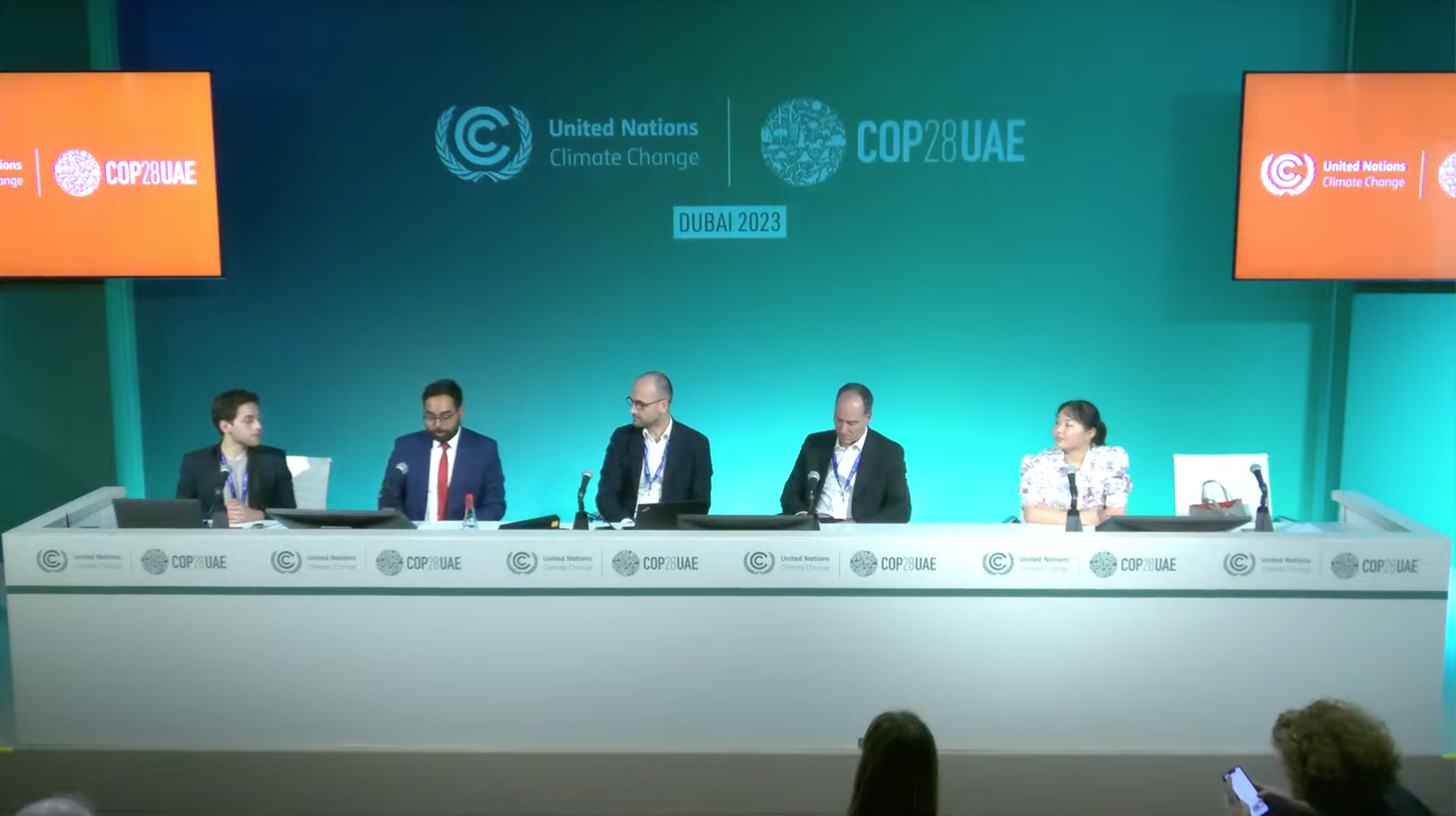Close
DUBAI — December 6, 2023 — With increased electricity demand from electrification and tackling energy poverty, the extensive use of raw materials and natural capital has become a growing issue. Hosted by the American Nuclear Society, the European Nuclear Society, and Nuclear for Climate, panelists at COP28 assessed how low-carbon energy sources measure up and discussed the options available to minimize the impact of different forms of energy on our planet. Panelists included Safi Syed, Project Manager at Urenco; Alexandre Marty, head of Climate and Natural Resources at EDF; John Wagner, Laboratory Director at Idaho National Lab; and Dinara Ermakova, Ph.D., nuclear engineer and nuclear advocate.
Moderator Patrick Carter Cortez began by applauding the fact that 22 countries have committed to tripling the global nuclear energy capacity by 2050 and 118 governments have pledged to triple the world's renewable energy capacity by 2030. He noted that it is vital to consider the broader context, including the mineral and rare earth elements inputs needed and the environmental impact and sustainability of clean energy initiatives.
Each speaker then provided introductory remarks. Syed explained that Urenco is a leading enrichment company for nuclear fuel. “More and more companies and countries are either extending the lifetime of existing nuclear power plants or deciding to build new nuclear power plants as one of the solutions to turn away from fossil fuels and to achieve net zero,” he said. He noted that we will need all available carbon-free technologies — renewables and nuclear, in combination with hydrogen. “Without nuclear, it will be impossible to meet our climate goals,” he explained.
Decarbonization of sectors such as steel production, heavy-duty transportation, and chemistry will increase demand for heat and baseload energy, dramatically boosting demand for nuclear power. Decarbonization and increased use of nuclear energy will also impact the security of the supply of enriched nuclear fuel. As a result of these trends, Urenco has increased capacity at all its enrichment sites.
“Depleted uranium or tails can be re-enriched to be used again,” said Syed. “Nuclear power is the only large-scale energy producing technology that takes full responsibility for all its waste and spent fuel, and the amount of waste generated by nuclear power is very small relative to other thermal electricity generation technologies. It produces less waste by volume than wind and solar. The land footprint of even a large nuclear power plant is comparatively small compared to other sectors, so it’s more supportive of the local environment and wildlife.”
Marty introduced EDF. “We operate 67 reactors, most in France and the UK. In mainland France, 96% of our power output is carbon-free, which contributes to making EDF the largest generator of zero-carbon electricity globally, together with other renewables technology ranging from hydro, wind, and solar, to geothermal.”
He then presented the results of a comprehensive study assessing the environmental footprint of different energy generation mixes. The study showed that nuclear power is the least carbon-intense and that it also consumes the least mineral resources.
Wagner explained that Idaho National Lab (INL) is leading advanced nuclear energy research and development for next-generation fuels and technologies in the U.S. The Lab is also using nuclear technologies for industrial processes like desalination. “Idaho National Laboratory is the site where nuclear power was originally demonstrated back in 1951, but now we work with many different companies, even those with non-high-temperature gas reactors,” he said.
Ermakova noted that there are many developing countries that are rich in resources, but that mining and production of the materials needed for nuclear power, batteries, solar panels, and so on can cause a lot of environmental impact. “It also impacts our energy security due to geopolitical issues,” she said. She noted that recycling of fuel, solar panels, and wind turbines will have to become the norm; however, most developing countries, out of necessity, are focused on other priorities.

Audience members posed questions about how to recycle depleted uranium and how to properly assess the land footprint of nuclear, including mining sites. “With respect to uranium tailings, many companies are mining the tailings for other valuable materials,” said Wagner. “Many mines are being reopened and the companies are making a profit and leaving the mine in a better state than how they found it.”
In terms of recycling, Syed noted that Urenco is using uranic materials for potential hydrogen storage. “There are certain places in the UK that are looking at the potential of reprocessing and putting it back into the fuel cycle as well,” said Syed. “Our National Nuclear Laboratory is also looking at the potential of extracting cancer treatments, medical radioisotopes from the radioactive waste.”
The audience also questioned the strength of the argument about environmental impact. “The environmental impact will be very dependent on where we mine things,” said Ermakova. “Because one country may have more stringent requirements for labor protections for the solutions used during extraction. The lack of formal policies and regulations for mining and environmental protections. Loopholes cause issues to occur more often.”
The panelists then discussed the opportunity to collocate mines with other parts of the value chain, such as enrichment, to minimize the environmental impacts of transporting materials to different facilities.
The discussion then turned to the potential for fast breeder reactors. “Those interested in moving fast with nuclear energy are attracted to known technologies. I expect you will see a lot of lightwater reactors deployed as we get more experience with fast reactors and advanced reactors and get their supply chains built out,” said Wagner. Concluded Ermakova, “Small modular reactors will add value for the developing world, because most of the countries cannot afford large-scale projects.”